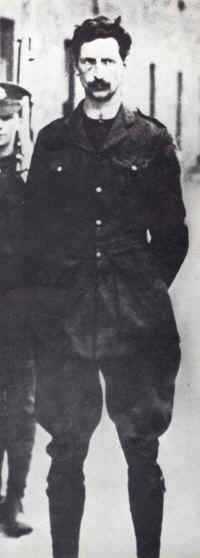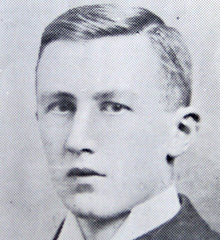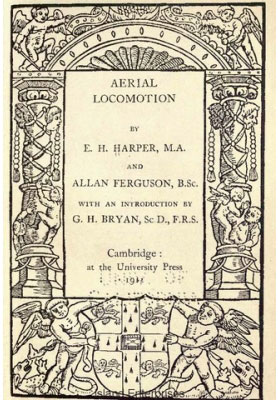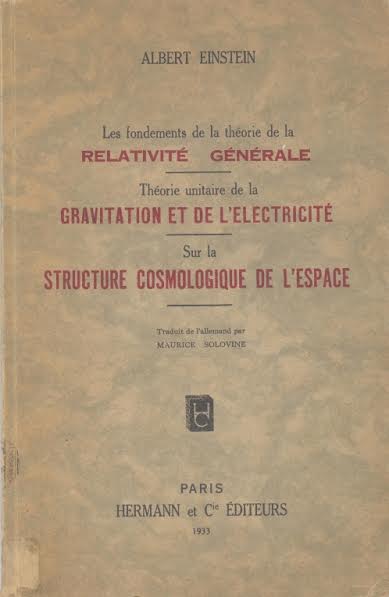Edgar Harper: the mathematician who changed the course of Irish history? (Sep 2016)
Sep 2016: Colm Mulcahy remembers a UCC mathematical physics professor who became a 1916 casualty
Harper forgotten by Irish history, despite his accidental role in changing it
Here’s a quick test of your knowledge of history from a century ago. What Irishman—a big rugby fan—was a finalist in the 1912 search for a new professor of mathematical physics at University College Cork, only to find by 1916 that his desire to fight for his country had superseded his professional ambitions with the result that his life was in great danger? Hint: his first name has five letters and starts with E.

The obvious answer is Éamon de Valera (1882-1975), but there was another, whose triumph over Dev in the UCC academic competition arguable changed the course of Irish history. De Valera joined the Irish Volunteers in November 1913, in time forsaking mathematics teaching for revolution1, and by mid-1916 had become the only Easter Rising leader not to pay for his actions with his life. The rest, well, the rest is our history.

The other man—the one who prevailed in the UCC chair of maths search—was Edgar Henry Harper (born 4 July 1880) from Tyrone. While the two initially tied in the vote by UCC’s Governing Body, the Northerner had some advantages over the NY-born and Limerick-reared future leader of the Free State and Republic, and these may have tipped the scales in his favour2. Dev attended post-graduate lectures at TCD after his 1904 pass degree from the Royal University of Ireland, but he did not earn a masters. Harper had an 1905 MA from RUI on top of his 1902 supplemental first moderator degree from TCD3, and 1904 RUI BA, and hence it's possible that the two men's paths crossed in mathematical circles in Dublin. Harper had another feather in his cap: in 1911, he'd co-authored the book Aerial Locomotion (Cambridge University Press)4, a remarkably early treatment of man’s triumph over gravity: the then-new art of flying.

Unlike Dev, Lieutenant Harper did die a century ago, on Monday 10th July 1916, as a member of the 8th Battalion of the South Staffordshire regiment at the Somme offensive known as the Battle of Albert5. He’s commemorated on the Great War Memorial in the 1937 Reading Room in TCD. As reported in the Irish Times on 22nd July 1916, Harper had walked away from the professorship in Cork to volunteer in the WWI effort, first securing a commission in the Royal Munster Fusiliers in May, 1915; later he was transferred to the South Staffordshire Regiment. He was the eldest son of Henry Harper and Annie Forbes of Northland Place, Dungannon, Tyrone, who’d already lost their youngest son Ernest at the Dardanelles the previous August.
One can’t help wondering if de Valera (who was imprisoned in England for the second half of 1916) ever learned that his former rival for the UCC job—who ironically was born on US Independence Day in 1880—had perished in that terrible conflict. De Valera’s granddaughter Nóra Ní Chuív6, herself one of the first Irish women to get a PhD in pure maths, says “I doubt it but I wouldn’t know, he never talked to me about things like that.” Nature ran an obituary of Harper, which gives some details of his mathematical contributions, but it seems unlikely Dev got to read that in jail.
Likewise, one wonders if Harper, presumably immersed in the war effort on the continent throughout the spring and early summer of 1916, ever knew of Dev’s leadership role in the 1916 rebellion back in Dublin and his subsequent close brush with death. Would those kind of details have made it to the battle front? We will probably never know.
Éamon De Valera’s most important contribution to matters mathematical wasn’t what he achieved in his early years, but his major role (much later, as Taoiseach) in the setting up of the Dublin Institute of Advanced Studies, which first opened for business 75 years ago. This came up at the 2016 Robert Boyle Summer School in Lismore, where Dr Cormac O'Raifeartaigh of WIT recalled that he’d recently been reading over de Valera’s own copy of Les fondements de la Théorie de la Relativité générale, which now resides in the DIAS library.

"It’s a 1933 collection of essays on general relativity by Einstein, translated into French by Maurice Solovine,” he remarked. Though decades had passed since polticics had taken over de Valera's life, “The notes in the margins in Dev's handwriting suggest that he was up to speed on the subject.”
Addenda: (1) It has claimed that Dev was teaching at St. Patrick's College, Maynooth, from 1912 to 1916, presumably up the Rising in April. However records examined there suggest that his appointment was only 1912 to 1914. (2) Harper contributed to another seminal book on aviation, Stability in Aviation (1911) by G. H. Bryan. In his "One Hundred Years of G. H. Bryan's Stability in Aviation" article, Jim Boyd writes extensively on Harper's role, including this paragraph:
Of greater significance in bringing Stability in Aviation to publication was the appointment of Edgar Henry Harper as Bryan's assistant in January 1909. Harper, a young Irish mathematician from Dungannon, lost no time in getting down to work. Bryan's review of Lanchester's Aerodonetics (cf. Section 7) had singled out Harper's success in drawing attention to a discrepancy in Lanchester's work. His contributions to Stability in Aviation, earned the handsome tribute Bryan paid him in his Preface, where he claimed priority for Harper in many of the results, as well as acknowledging his independent working of all the formulae in the book.
(last updated 20 Oct 2019)
Notes:
1. More on the contested UCC job in 1912 may be found here, there, and yonder. The referenced 2009 PhD on the topic is listed at UCC.
2. The MacTutor biography of De Valera from a mathematical perspective is informative.
3. This 1901 Census entry oddly lists Harper as a TCD graduate, a year early. The same census had Edward De Valera as a student, and a decade later (using the same name) as a married professor (he taught maths at various schools). By 1911, Harper was lecturing in maths at the University College of North Wales, in Bangor, having first taught at the Royal School in Dungannon (which he's attended himself).
4. The Aerial Locomotion book may be surveyed here.
5. Some images and information used courtesy of the Dungannon War Dead Database. However, some of the dates listed there are erroneous.
6. Dr. Ní Chuív recalls learning about Hamilton’s quaternions at a very early age from her grandfather, and his encouragement certainly played a role in her career choice. She has recently retired to Dublin after a long academic career in Canada.